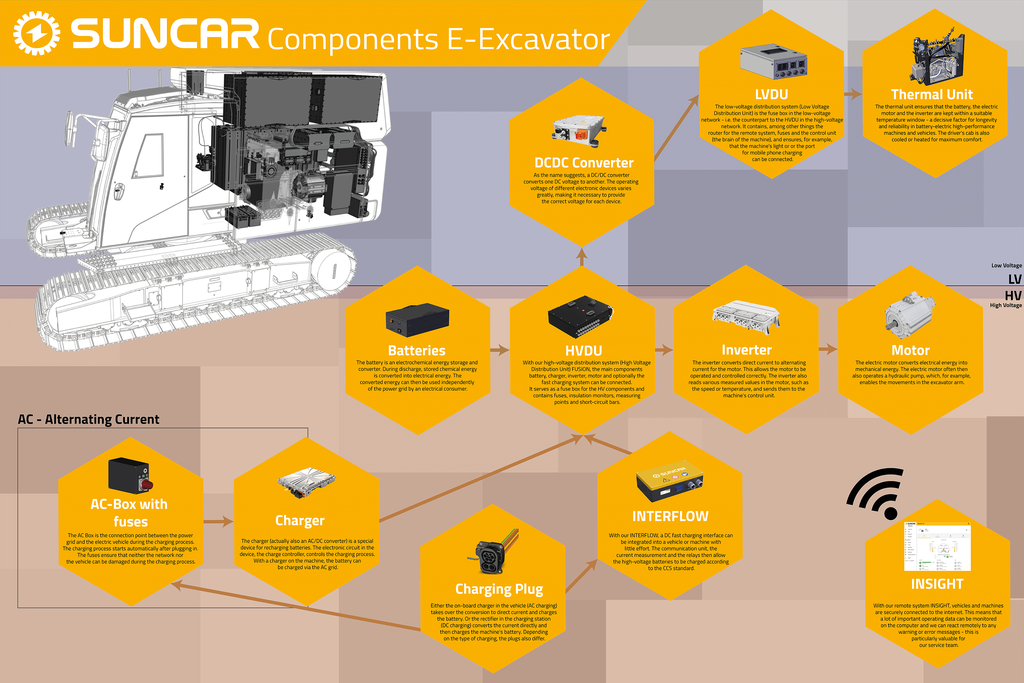6-t Excavator Redesign
Exciting news: The SUNCAR 6 t electric excavator will soon be revised! In addition to technical innovations and improvements, the new edition will also have a new design.
Take a look at the diagram below to see what drives an electric excavator (simplified, of course).

AC Box with fuses
The AC Box is the connection point between the power grid and the electric vehicle during the charging process. The charging process is started automatically after plugging in. The fuses ensure that neither the mains nor the vehicle can be damaged during the charging process.
Charger
The charger (actually also an AC/DC converter) is a special device for recharging batteries. The electronic circuit in the device, the charge controller, controls the charging process. With a charger on the machine, the battery can be charged via the AC mains.
Charging Plug
Either the on-board charger in the vehicle (AC charging) takes over the conversion to direct current and charges the battery. Or the rectifier in the charging station (DC charging) converts the current directly and then charges the machine's battery. The plugs also differ depending on the type of charging.
INTERFLOW
With our INTERFLOW, a DC fast charging interface can be integrated into a vehicle or machine with little effort. The communication unit, current measurement and relays then enable high-voltage batteries to be charged in accordance with the CCS standard.
INSIGHT
With our INSIGHT remote system, vehicles and machines are securely connected to the internet. This means that many important operating data can be monitored on the computer, and we can react directly from a distance in the event of any warnings or error messages - this is particularly valuable for our service team.
Batteries
The battery is an electrochemical energy store and converter. During discharge, stored chemical energy is converted into electrical energy. The converted energy can then be used by an electrical consumer independently of the power grid.
HVDU
Our High Voltage Distribution Unit (HVDU) FUSION can be used to connect the main components battery, charger, inverter, motor and optionally the rapid charging system.
It serves as a fuse box for the HV components and contains fuses, insulation monitoring, measuring points and short-circuit brackets.
Inverter
The inverter converts direct current for the motor into alternating current. This allows the motor to be operated and controlled correctly. The inverter also reads various measured values in the motor, such as the speed or temperature, and sends them to the machine's control unit.
Motor
The electric motor converts electrical energy into mechanical energy and often also operates a hydraulic pump, which enables the movements of the excavator arm, for example.
DCDC-Converter
As the name suggests, a DC/DC converter converts one DC voltage into another. The operating voltage of different electronic devices varies greatly, making it necessary to provide the correct voltage for each device.
LVDU
The low-voltage distribution unit (LVDU) is the fuse box in the low-voltage grid - i.e. the counterpart to the HVDU in the high-voltage grid. Among other things, it contains the router for the remote system, fuses and the control unit (brain of the machine) and ensures that, for example, the machine's light or the port for charging mobile phones can also be connected.
Thermal Unit
The thermal unit ensures that the battery, electric motor and inverter are kept within a suitable temperature range - a decisive factor for the longevity and reliability of high-performance battery-powered machines and vehicles. It also cools or heats the driver's cab for maximum comfort.